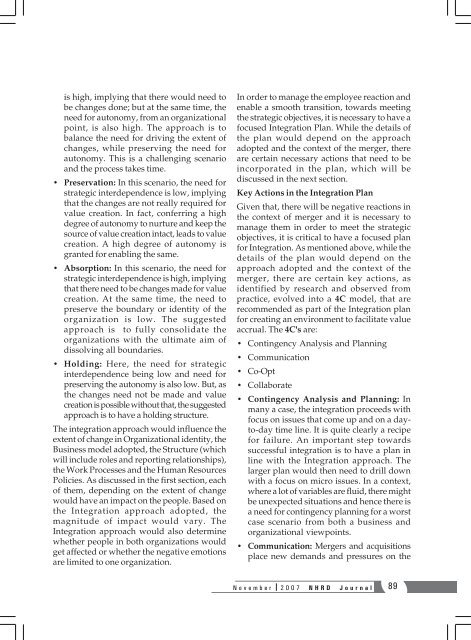NHRD Journal - National HRD Network
NHRD Journal - National HRD Network
NHRD Journal - National HRD Network
Create successful ePaper yourself
Turn your PDF publications into a flip-book with our unique Google optimized e-Paper software.
is high, implying that there would need to<br />
be changes done; but at the same time, the<br />
need for autonomy, from an organizational<br />
point, is also high. The approach is to<br />
balance the need for driving the extent of<br />
changes, while preserving the need for<br />
autonomy. This is a challenging scenario<br />
and the process takes time.<br />
• Preservation: In this scenario, the need for<br />
strategic interdependence is low, implying<br />
that the changes are not really required for<br />
value creation. In fact, conferring a high<br />
degree of autonomy to nurture and keep the<br />
source of value creation intact, leads to value<br />
creation. A high degree of autonomy is<br />
granted for enabling the same.<br />
• Absorption: In this scenario, the need for<br />
strategic interdependence is high, implying<br />
that there need to be changes made for value<br />
creation. At the same time, the need to<br />
preserve the boundary or identity of the<br />
organization is low. The suggested<br />
approach is to fully consolidate the<br />
organizations with the ultimate aim of<br />
dissolving all boundaries.<br />
• Holding: Here, the need for strategic<br />
interdependence being low and need for<br />
preserving the autonomy is also low. But, as<br />
the changes need not be made and value<br />
creation is possible without that, the suggested<br />
approach is to have a holding structure.<br />
The integration approach would influence the<br />
extent of change in Organizational identity, the<br />
Business model adopted, the Structure (which<br />
will include roles and reporting relationships),<br />
the Work Processes and the Human Resources<br />
Policies. As discussed in the first section, each<br />
of them, depending on the extent of change<br />
would have an impact on the people. Based on<br />
the Integration approach adopted, the<br />
magnitude of impact would vary. The<br />
Integration approach would also determine<br />
whether people in both organizations would<br />
get affected or whether the negative emotions<br />
are limited to one organization.<br />
In order to manage the employee reaction and<br />
enable a smooth transition, towards meeting<br />
the strategic objectives, it is necessary to have a<br />
focused Integration Plan. While the details of<br />
the plan would depend on the approach<br />
adopted and the context of the merger, there<br />
are certain necessary actions that need to be<br />
incorporated in the plan, which will be<br />
discussed in the next section.<br />
Key Actions in the Integration Plan<br />
Given that, there will be negative reactions in<br />
the context of merger and it is necessary to<br />
manage them in order to meet the strategic<br />
objectives, it is critical to have a focused plan<br />
for Integration. As mentioned above, while the<br />
details of the plan would depend on the<br />
approach adopted and the context of the<br />
merger, there are certain key actions, as<br />
identified by research and observed from<br />
practice, evolved into a 4C model, that are<br />
recommended as part of the Integration plan<br />
for creating an environment to facilitate value<br />
accrual. The 4C's are:<br />
• Contingency Analysis and Planning<br />
• Communication<br />
• Co-Opt<br />
• Collaborate<br />
• Contingency Analysis and Planning: In<br />
many a case, the integration proceeds with<br />
focus on issues that come up and on a dayto-day<br />
time line. It is quite clearly a recipe<br />
for failure. An important step towards<br />
successful integration is to have a plan in<br />
line with the Integration approach. The<br />
larger plan would then need to drill down<br />
with a focus on micro issues. In a context,<br />
where a lot of variables are fluid, there might<br />
be unexpected situations and hence there is<br />
a need for contingency planning for a worst<br />
case scenario from both a business and<br />
organizational viewpoints.<br />
• Communication: Mergers and acquisitions<br />
place new demands and pressures on the<br />
November 2007 <strong>N<strong>HRD</strong></strong> <strong>Journal</strong> 89
















